新人教版七年级英语上册全册教案
人教版七年级英语上册教案全套
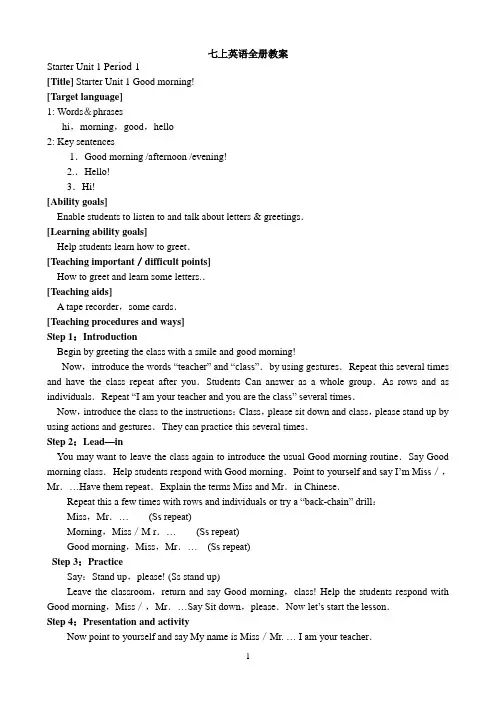
S: Good morning, I’m Jacky Cheng.
T: Nice to meet you, Jacky.
S: Nice to meet you, too. Bill.
Encourage the students to care what kind of English they can find in the street or in the other ways. Show the students some CDs and ask them if they know what it is. Repeat with the other things. And add some more things such as DVD and KFC. Train the students to care the things happening around them, such as: ID means identification card. OK means all right. Then get them to finish the exercise on the screen. Go on doing the above step to ask them to list more about the abbreviation. (See the powerpoint)
S2:Nice to meet you.too.
Call out several pairs of students to give their performance.Praise their efforts as much as possible.Help the slower students with patience.
2024-2024年学年秋季学期人教版pep初中七年级英语上册教案全册
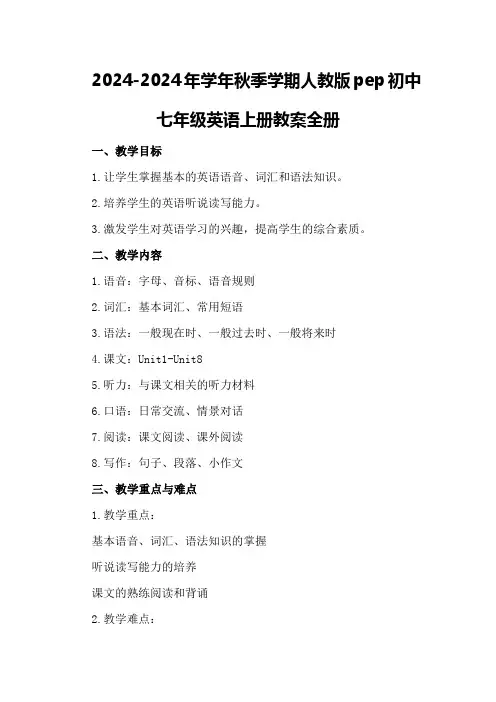
2024-2024年学年秋季学期人教版pep初中七年级英语上册教案全册一、教学目标1.让学生掌握基本的英语语音、词汇和语法知识。
2.培养学生的英语听说读写能力。
3.激发学生对英语学习的兴趣,提高学生的综合素质。
二、教学内容1.语音:字母、音标、语音规则2.词汇:基本词汇、常用短语3.语法:一般现在时、一般过去时、一般将来时4.课文:Unit1-Unit85.听力:与课文相关的听力材料6.口语:日常交流、情景对话7.阅读:课文阅读、课外阅读8.写作:句子、段落、小作文三、教学重点与难点1.教学重点:基本语音、词汇、语法知识的掌握听说读写能力的培养课文的熟练阅读和背诵2.教学难点:音标发音的准确性语法规则的灵活运用课外阅读的理解与分析四、教学进度安排1.第一周:Unit11.1Greetingsandintroductions 1.2Numbersandages1.3Colors2.第二周:Unit22.1Schoolsubjects2.2Classroomobjects2.3Dlyroutines3.第三周:Unit33.1Foodanddrink3.2Describingfood3.3Makingrequests4.第四周:Unit44.1Familymembers4.2Describingpeople4.3Talkingaboutfamily5.第五周:Unit55.1Time5.2Daysoftheweek5.3Activities6.第六周:Unit66.1Weather6.2Clothing6.3Describingtheweather7.第七周:Unit77.1Inthelibrary7.2Intheclassroom7.3Inthesupermarket8.第八周:Unit88.1Sports8.2Describingsports8.3Talkingaboutsports五、教学方法1.采用任务型教学法,让学生在实际语境中学习英语。
七年级上册英语教案人教版免费

七年级上册英语教案人教版免费(经典版)编制人:__________________审核人:__________________审批人:__________________编制单位:__________________编制时间:____年____月____日序言下载提示:该文档是本店铺精心编制而成的,希望大家下载后,能够帮助大家解决实际问题。
文档下载后可定制修改,请根据实际需要进行调整和使用,谢谢!并且,本店铺为大家提供各种类型的经典范文,如工作总结、述职报告、策划方案、演讲致辞、合同协议、条据文书、教案资料、好词好句、作文大全、其他范文等等,想了解不同范文格式和写法,敬请关注!Download tips: This document is carefully compiled by this editor. I hope that after you download it, it can help you solve practical problems. The document can be customized and modified after downloading, please adjust and use it according to actual needs, thank you!Moreover, our store provides various types of classic sample essays for everyone, such as work summaries, job reports, planning plans, speeches, contract agreements, doctrinal documents, lesson plans, good words and sentences, complete essays, and other sample essays. If you want to learn about different sample formats and writing methods, please pay attention!七年级上册英语教案人教版免费最新七年级上册英语教案人教版免费(8篇)作为一位不辞辛劳的人·民教师,通常会被要求编写教案,那么关于七年级上册英语教案怎么写呢?以下是本店铺准备的一些七年级上册英语教案人教版免费,仅供参考。
七年级英语上册人教版全册教案
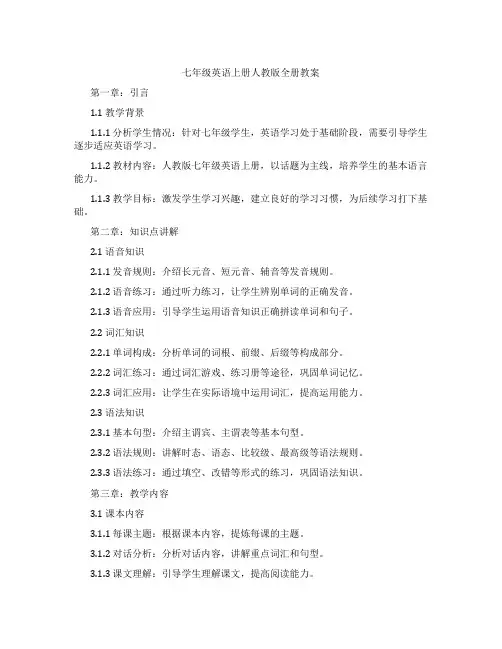
七年级英语上册人教版全册教案第一章:引言1.1 教学背景1.1.1 分析学生情况:针对七年级学生,英语学习处于基础阶段,需要引导学生逐步适应英语学习。
1.1.2 教材内容:人教版七年级英语上册,以话题为主线,培养学生的基本语言能力。
1.1.3 教学目标:激发学生学习兴趣,建立良好的学习习惯,为后续学习打下基础。
第二章:知识点讲解2.1 语音知识2.1.1 发音规则:介绍长元音、短元音、辅音等发音规则。
2.1.2 语音练习:通过听力练习,让学生辨别单词的正确发音。
2.1.3 语音应用:引导学生运用语音知识正确拼读单词和句子。
2.2 词汇知识2.2.1 单词构成:分析单词的词根、前缀、后缀等构成部分。
2.2.2 词汇练习:通过词汇游戏、练习册等途径,巩固单词记忆。
2.2.3 词汇应用:让学生在实际语境中运用词汇,提高运用能力。
2.3 语法知识2.3.1 基本句型:介绍主谓宾、主谓表等基本句型。
2.3.2 语法规则:讲解时态、语态、比较级、最高级等语法规则。
2.3.3 语法练习:通过填空、改错等形式的练习,巩固语法知识。
第三章:教学内容3.1 课本内容3.1.1 每课主题:根据课本内容,提炼每课的主题。
3.1.2 对话分析:分析对话内容,讲解重点词汇和句型。
3.1.3 课文理解:引导学生理解课文,提高阅读能力。
3.2 拓展内容3.2.1 相关话题:针对课本内容,拓展相关话题。
3.2.2 听力练习:选择合适的听力材料,提高学生听力水平。
3.2.3 口语表达:组织口语交流活动,提高学生口语表达能力。
第四章:教学目标4.1 知识目标4.1.1 掌握基本的语音、词汇和语法知识。
4.1.2 能够听懂、说出一日常用语。
4.1.3 理解课本内容,具备一定的阅读和写作能力。
4.2 能力目标4.2.1 提高学生的听、说、读、写四项基本技能。
4.2.2 培养学生的语言运用能力和团队协作能力。
4.2.3 培养学生的跨文化交际意识。
新人教版七年级英语上册全册教案
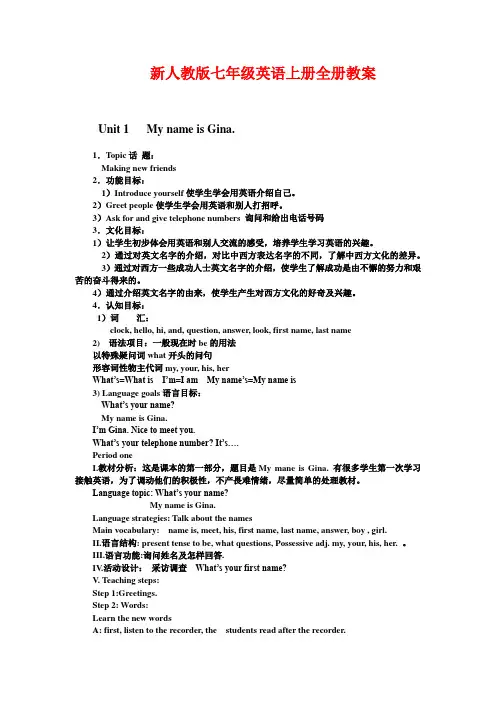
新人教版七年级英语上册全册教案Unit 1 My name is Gina.1.Topic话题:Making new friends2.功能目标:1)Introduce yourself使学生学会用英语介绍自己。
2)Greet people使学生学会用英语和别人打招呼。
3)Ask for and give telephone numbers 询问和给出电话号码3.文化目标:1)让学生初步体会用英语和别人交流的感受,培养学生学习英语的兴趣。
2)通过对英文名字的介绍,对比中西方表达名字的不同,了解中西方文化的差异。
3)通过对西方一些成功人士英文名字的介绍,使学生了解成功是由不懈的努力和艰苦的奋斗得来的。
4)通过介绍英文名字的由来,使学生产生对西方文化的好奇及兴趣。
4.认知目标:1)词汇:clock, hello, hi, and, question, answer, look, first name, last name2) 语法项目:一般现在时be的用法以特殊疑问词what开头的问句形容词性物主代词my, your, his, herWhat‘s=What is I‘m=I am My name‘s=My name is3) Language goals语言目标:What‘s your name?My name is Gina.I‘m Gina. Nice to meet you.What‘s your telephone number? It‘s….Period oneI.教材分析:这是课本的第一部分,题目是My mane is Gina. 有很多学生第一次学习接触英语,为了调动他们的积极性,不产畏难情绪,尽量简单的处理教材。
Language topic: What‘s your name?My name is Gina.Language strategies: Talk about the namesMain vocabulary: name is, meet, his, first name, last name, answer, boy , girl.II.语言结构: present tense to be, what questions, Possessive adj. my, your, his, her. 。
全新人教版七年级英语上册全英文教案(全册 全英文p)
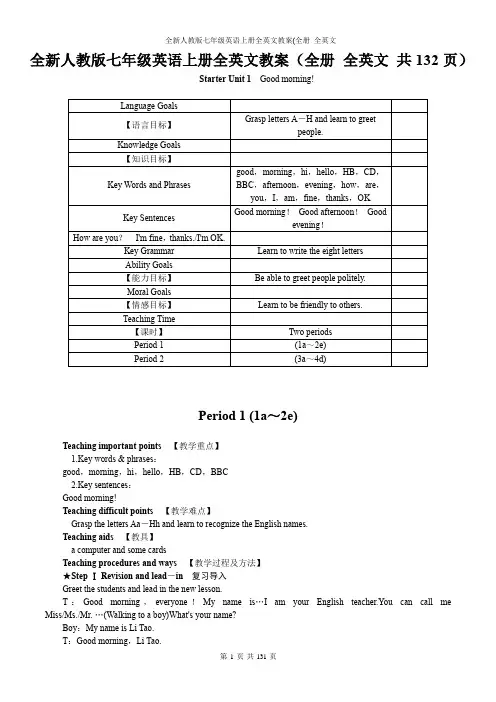
全新人教版七年级英语上册全英文教案(全册全英文全新人教版七年级英语上册全英文教案(全册全英文共132页)Starter Unit 1Good morning!Period 1 (1a~2e)Teaching important points【教学重点】1.Key words & phrases:good,morning,hi,hello,HB,CD,BBC2.Key sentences:Good morning!Teaching difficult points【教学难点】Grasp the letters Aa-Hh and learn to recognize the English names.Teaching aids【教具】a computer and some cardsTeaching procedures and ways【教学过程及方法】★Step Ⅰ Revision and lead-in复习导入Greet the students and lead in the new lesson.T:Good morning,everyone!My name is…I am your English teacher.You can call me Miss/Ms./Mr. …(Walking to a boy)What's your name?Boy:My name is Li Tao.T:Good morning,Li Tao.Boy:Good morning,Ms./Mr. …(Help the student to respond correctly if necessary.)The teacher writes “Good morning,Li Tao.”on the blackboard.★Step Ⅱ Self-studying and guiding自学指导Self-study guide 1:Self-study the new words and English names:good,morning,hi,hello,Alice,Bob,Cindy,Dale,Eric,Frank,Grace,Helen.Learn to pronounce them according to the phonetic symbols(音标).And you can listen to the tapes to help you pronounce them correctly or ask others for help.Self-study guide 2:Try reading the sentences in 1a and try to tell boys' names from girls' names.Self-study guide 3:Self-study 2c and learn to write the eight letters.Questions for thinking:1.Do you know how to greet people in the morning?2.Do you know how to write the eight letters Aa,Bb,Cc,Dd,Ee,Ff,Gg,Hh?The teacher walks around the classroom to watch and help the students study while the students are self-studying.Time for questions:Discuss the writing of the eight letters.★Step Ⅲ Check up检查核对Check up 1:Words teaching:Ask a few students to read the new words and help them correct the mistakes in pronunciation if necessary.Check up 2:Ask some students to make a conversation with their partner and see if they can respond correctly.And ask students to fill in the blanks:Boys' names:________________________________________________________________________ Girls' names:________________________________________________________________________Check up 3:Write the small letters for these big letters:A____B____C____D____E____F____G____H____★Step Ⅳ Cooperative inquiry合作探究1.Listening (1b)Play the recording of 1a,students listen and repeat.2.Pair workPractice the conversations in the picture and then greet your partner.(1c)Sample:A:Good morning,Zhang Wen!/Hello,Zhang Wen!B:Good morning,Li Yan!/Hello,Li Yan!3.Act outAsk some pairs of students to act out their dialogs in front of the class.4.Finish 2a and 2b.5.Discussion (2e)Talk about what these letters HB,CD,BBC mean.★Step Ⅴ Practice练习Write the missing big letter or small letter for each pair.(2d)★Step Ⅵ Test测试Choose the best answer.()1.书写英文字母时,占三格的是________。
2024人教版七年级上册英语教案
2024人教版七年级上册英语教案1. Course InformationTextbook: 2024 People’s Education Press 7th Grade Book 1.Unit: Unit 1-Unit X adjust based on the textbook.Class Duration: 45 minutes.2. Learning Objectivesa. Language Objectives:Learn and use key vocabulary and sentence structures from the unit.Engage in basic daily conversations.b. Skill Objectives:Improve listening, speaking, reading, and writing skills.Understand and use key sentence patterns from the text.c. Emotional Objectives:Foster interest and confidence in learning English.Enhance teamwork and communication skills.3. Lesson ContentText: Dialogues, short texts, and stories from the unit.Vocabulary: New words and phrases from the unit.Grammar: Key grammar points from the unit.Functional Sentences: Core sentences and expressions from the unit.4. Teaching Stepsa. Introduction (5 minutes)Use images, videos, or questions to introduce the lesson theme.Engage students and outline the learning objectives.b. New Content (15 minutes)Vocabulary: Introduce and explain new words, focusing on pronunciation, spelling, and meaning.Grammar: Explain key grammar points with examples.Sentence Patterns: Demonstrate core sentence structures and practice.c. Text Learning (10 minutes)Read the text aloud and discuss its content.Engage in group discussions or role-plays to practice dialogues.d. Practice (10 minutes)Complete related exercises such as fill-in-the-blanks, matching, and multiple-choice questions.Use group activities or games to reinforce vocabulary and sentence structures.f. Summary and Homework (5 minutes)Review the lesson’s content and address any student questions.Assign homework, such as vocabulary practice, writing tasks, or reading assignments.5. Homework AssignmentsVocabulary Practice: Complete exercises from the textbook.Writing Task: Write a short paragraph using the new vocabulary and sentence structures.Listening Exercise: Listen to recordings and complete related comprehension questions.6. AssessmentOral Evaluation: Assess student participation and performance in class.Written Evaluation: Evaluate homework and exercise accuracy.7. ReflectionReflect on the effectiveness of the lesson based on student feedback and observation.Note areas for improvement for future lessons.。
七年级上册英语教案人教版5篇
七年级上册英语教案人教版5篇最新七年级上册英语教案人教版5篇教案是教师教学过程中必不可少的指导工具,能够提升教学质量和效果。
下面是小编为大家整理的七年级上册英语教案人教版,如果大家喜欢可以分享给身边的朋友。
七年级上册英语教案人教版篇1Language goalIn this unit, students learn to talk about jobs.New languageWhat do you do I m a reporterWhat does he do. He s a student.What do you want to be I want to be an actor .What does she want to be She wants to be a police officernames of jobs and professionsSection ABrainstorm with students a list of jobs that friends or relatives do. ( Brainstorming is an activity in which you set a topic and students say whatever words they can think of relating to that topic.) Write the word jobs on the board and list all the jobs students mention.Point to the jobs one by one and ask students to say what ever they can about these jobs. Accept single word answers or simple sentences such as, It s fun. It s a good job.la This activity introduces the key vocabulary.Focus attention on the art. Ask students to tell what they see in each scene. Ask students to name as many of the jobs shown as theycan. Then point to a scene, name the job, and ask students to repeat. Point to the numbered list of words. Say each one and ask students to repeat.Then ask students to match each word wllfa one of the scenes. Say, Write the letter of each scene next to one of the ivords. Point tothe sample answer.1 b This activity gives students practice in understanding thetarget language in spoken conversation.Point to the different people shown in the picture.Ask various students to tell what they do as you point to each one,Say, Now you will hear three conversations. The conversations are about three of the people in this picture.Play the recording the first time. Students only listen.Play the recording a second time. This time ask students to write a number 1 next to the person being talked about in conversation 1. Have students put a 2 and 3 next to the people being talked about in conversations 2 and 3.Correct the answers.1 c This activity provides guided oral practice using the target language-Ask a student to read the example conversation with you. Hold upthe book and point to the doctor in the picture.Say, Now work with your partner. Make your own conversations about the picture. You can use sentences like the ones in activity 1b.Say a dialogue with a student. Point to a picture of one of the people. Guide the student to answer using one of the words inactivity 1a.As students work in pairs, move around the room monitoring theirwork. Oner language or pronunciation support as needed.2a This activity gives students practice in understanding thetarget language in spoken conversation.Ask students to look at the three pictures. Ask different students to tell you what they sec in each picture. What are the people doing What jobs do they havePlay the recording the first time. Students only listen.Say, You will hear conversations about the people in these pictures.Play the recording a second time. Say, Write the number of each conversation below the picture of the person being talked about.Correct the answers.2b This activity gives students practice in understanding thetarget language in spoken conversation.Point to the three headings in the chart and read the headings to the class. Ask students, What does wants to be mean (It is not the Job the person lias now. It is the job the person wants in the future.)Play the recording the first time. Students only listen.Say, You wiU hear about the people in these pictures. You will hear the job they haw now and the job they want in the future.Play the recording a second time. This time ask students to fill in the blanks with the jobs the people have now and the ones they wantin the future. Point out the sample2c This activity provides guided oral practice using the target language.Point out the pictures in activity 2a. Ask who each person is. (They are Susan s brother. Anna s mother, and Tony s father.)Say, Now work with your partner. Ask and answer questions about thepictures. Ask, What does he or she do Then ask, What does he or she want to beSay a dialogue with a student. Point to Anna s mother and then to the example in the speech balloons. Practice the dialogue with a student.As students work In pairs, move around the room monitoring their work. Offer language support as needed.3a This activity introduces the names for the places where people work, and gives reading practice using the target language.Call attention to the pictures. Ask students to read the name for each place. As they name each place, write the word on the board and-ask the class to repeat it.Point out the list of jobs with the numbers next to each. Then call attention to the people in the pictures and the speech bubbles. Point out the sample answer and have a student read out the speech bubble. Ask students to work alone. Say, Write the number of each job in the square next to each workplace.Check the answers.3b This activity provides guided oral practice using the target language.Point out the pictures in activity 3a. Ask students to name the workplace shown In each picture.Then point out the conversation in the speech bubbles. Ask two students to read It to the class.Say, Wow work with a partner. First practice the conversation in the picture. Then make new conversations. Use jobs and places from activity 3a.Say a dialogue with a student. Point to the word waiter in activity3a and then to the picture of the restaurant. Ask a student. Where does he work Guide the student to answer using the correct place: He works in a restaurant.Then ask. What does he do and guide the student to answer, He s a waiter.As students work in pairs, move around the room monitoring their work. Offer language support as needed.4 This activity provides listening and speaking practice using the target language.Call attention to the pictures in the book showing how to play the game. Say, You will draw a picture of someone working. Other students will ask questions about the kind of job you are drawing. After two questions someone can try to guess the job.Demonstrate by drawing a picture on the board of a stick figure reporter. Add details (microphone, notebook,etc.) until students guess what job it is.Ask a student to go to the board. Say, Draw a picture of a person working. If necessary, help the student add details that show the job the person is doing. He or she can add a bank interior to show that the person is a bank clerk. A student could also use an eye chart on the wall to show that the place is a doctor s office and the personis a doctor.Ask two different students to ask questions about the Job, and then ask a third student to guess what job it is.Play the game using drawings by several different students.Alternative: If you do not want students to move from their seats, then you can ask them to do this activity sitting down in groups of four. They will need pieces of paper on which to draw their pictures. They will also need pencils.Section BNew languageWords that describe jobs, such as exciting, dangerous,boring, difficult, busy, funAdditional materials to bring to class:help wanted ads from an English-language newspaper1 a This activity introduces the key vocabulary.Focus attention on the six pictures. Ask, What job does the person have Where does the person ivnrkPoint out the numbered list of words. Say each one and ask students to repeat. Then use simple explanations and short sample sentences to help students understand what each word means. For example, Exciting means very interesting and very fast-moving. A police officer has an exciting job. The job is always changing. Something is always happening. For dangerous you might say, Dangerous means not safe. You might be hurt or killed in a dangerous job.Then ask students to match each word with one of the pictures. Say, Write the letter of each picture next to one of the words. Point out the sample answer.Check the answers.1 b This activity provides guided oral practice using the target language.Call attention to the picture In this activity and ask a student to read the statement to the class. Then point to the picture of the police officer and say. It s an exciting job. Ask the class to repeat. Then say, What else can you say about being a police officer Someone may answer, It s a dangerous job. Ask the class to repeat each correct answer.Then ask students to work in pairs. Suggest that they each point to the pictures of the workers and make statements about them. As students practice, move around the classroom monitoring their work.1 c This activity provides an opportunity for oral practice.Say, Name some of the jobs from this unit. Write this list of jobs on the board. Say, Can you name some other jobs Add any new jobs to the list.Ask some students to make statements about Jobs on the list using the words in activity la. You may wish to write some of the sentences on the board so that students can copy the sentences into their notebooks.2a This activity provides listening and writing practice with the target language.Call attention to the two headings and ask a student to read die headings to the class.Point out the blank lines where students will write the name of a job (under the words wants to be).Play Ihe recording the first time. Students only listen.Say, Now I will play the tape again. This time write the name of a job under the words wants to be.2b This activity provides listening and writing practice with the target language,Call attention to the second heading and ask a student to read it to the class. Say, This time you will unite why each person wants the job.Play the recording again. Students only listen.Then say, Now I will play the tape again. This time write the reason the person wants the job under the word WhyPlay the recording. Students write their answers.Check the answers.2C This activity provides open-ended oral practice using the target language.Say, What do you want to be What words describe each job Help the class make up a list of jobs they might like to do. As students suggest possible jobs, ask the class to suggest words to describe them. Use a bilingual dictionary, if necessary, to find the names of jobs and words to describe each one.Then ask students to work in small groups. They tell each otherwhat they want to do and why. Encourage students to use dictionariesif necessary. Move from group to group offering assistance as needed. Ask individual students to tell the class about what they want tobe and why.3a This activity provides reading and writing practice using the target language.Call attention to the three newspaper ads and read these ads to the class. Say blank each time you come to a blank line.Then read each ad again separately, pausing to allow students toask questions about anything they don t understand. For example, in the first ad, students may not know that working late means workingat night. To work hard means to use a lot of energy to do the job.Ask students to fill In (he blanks in the ads using the words actor, reporter, and waiter.Check the answers.3b This activity provides reading and writing practice using the target language.Call attention to the newspaper ad and ask a student to read it,saying blank for each blank line.Ask students to fill in the blanks using words from This section. Say,Look at the pictures next to each blank line. The pictures will help you guess the correct word.Suggest that they look at the names of jobs and the words that describe jobs in the first part of Section B.Check the answers,3c This activity provides writing practice using the targetlanguage.Point out the blank strip of newspaper where students can write their own ads.Ask one or two students, What are you going to write about Repeat each of the students sentences and ask the class to repeat the sentences after you. For example: Do ^OM want an interesting but dangerous job Do you want to meet new people We need a police officer.Call the Smithtown Police Station at 555-2323.Ask students to read their ads to a partner. Ask the pairs to correct each other s work.4 This activity provides guided oral practice using thetarget language.Ask two students to read the conversation in the speech bubbles. Answer any questions students may have about it.Then say, New please work in groups. Ask efuestions to find out what jobs each person wrote about. You can use sentences like the ones we just read.As students ask questions, move from group to group. Rephrase any incomplete or incorrect questions.Also rephrase any inaccurate answers.七年级上册英语教案人教版篇2Unit 3 Language in use课型 Revision and application教材分析 Unit 3 对“自我介绍和获取信息”的功能句式进行综合训练:谈论自己或朋友的情况(活动1);根据提示完成介绍图片中人物情况的句子;填表、匹配复习表示国家、民族及人物活动的词汇。
人教版七年级英语上册(全册)精品全英教案汇总
人教版七年级英语上册(全册)精品全英教案汇总一、Unit 1Lesson 1- Title: Greetings and Introductions- Objective: To learn basic greetings and introductions- Time: 40 minutes- Materials: PowerPoint presentation, flashcards, handouts- Procedure:1. Warm-up: Greet the students and introduce yourself.2. Presentation:- Introduce basic questions for introductions.3. Practice:- Divide the students into pairs or small groups.- Give each group a set of flashcards with different greetings and responses.- Have the students take turns greeting each other and responding.4. Production:- Distribute handouts with a list of questions for introductions.- Have the students interview each other using the questions.5. Conclusion: Recap the lesson and highlight key phrases.Lesson 2- Title: Numbers and Classroom Objects- Objective: To learn numbers and classroom objects- Time: 45 minutes- Materials: PowerPoint presentation, flashcards, real objects- Procedure:1. Warm-up: Review the greetings from the previous lesson.2. Presentation:- Introduce numbers 1-100 using visual aids.- Teach vocabulary related to classroom objects.3. Practice:- Show flashcards with different numbers and have the students say them aloud.- Bring in real classroom objects and ask the students to identify them.4. Production:- Divide the students into groups.- Give each group a set of number flashcards and object cards.- Have the students match the numbers with the corresponding objects.5. Conclusion: Recap the lesson and review the vocabulary.二、Unit 2Lesson 1- Title: Personal Information- Objective: To learn how to talk about personal information- Time: 40 minutes- Materials: PowerPoint presentation, worksheets- Procedure:1. Warm-up: Review the numbers from the previous unit.2. Presentation:- Teach vocabulary related to personal information (name, age, nationality, etc.).- Introduce basic sentence structures for talking about personal information.3. Practice:- Distribute worksheets with fill-in-the-blank sentences.4. Production:- Divide the students into pairs.- Instruct them to interview each other and ask about personal information.5. Conclusion: Recap the lesson and encourage the students to practice asking and answering questions about personal information.Lesson 2- Title: Colors and Clothes- Objective: To learn colors and clothing vocabulary- Time: 45 minutes- Materials: PowerPoint presentation, flashcards, colored paper - Procedure:1. Warm-up: Review the vocabulary from the previous lesson.2. Presentation:- Introduce basic colors using visual aids.- Teach vocabulary related to clothing.3. Practice:- Show flashcards with different colors and have the students say them aloud.- Show flashcards with different clothing items and have the students identify them.4. Production:- Give each student a piece of colored paper.- Instruct them to draw and label a piece of clothing using the color of the paper.5. Conclusion: Recap the lesson and review the vocabulary.三、Unit 3... (continue to provide summaries for each lesson in Unit 3 and subsequent units)Please note that the above are just examples of how the document could be structured. You can provide detailed summaries of each lesson in the "Unit X" section, following a similar format. Remember to adapt the content to fit the actual lessons and materials provided in the textbook.。
新人教版七年级英语上册教案
新人教版七年级英语上册教案教师独立钻研教材,创造性进行教学设计,把对教材的理解,进行创造性加工的东西备在书上,而在教案中重点突出程序与环节的设计、教法与学法的运用。
下面是小编为大家精心整理的新人教版七年级英语上册教案,仅供参考。
新人教版七年级英语上册教案(一)Unit 6 Do you like bananas?单元整体说明单元教材分析本单元主要学习动词like的肯定句、否定句的用法;动词like的一般疑问句的用法以及肯定与否定的回答。
本单元以介绍食物,谈论喜欢与厌恶为主题,设计了三个任务:先是搜集、利用图片来介绍有关的食物,学习一些食物名词;然后是学习询问对方喜欢与不喜欢的食物,掌握动词like的一般疑问句的构成以及它的肯定、否定的回答;最后是用所学过的食物名词制定一次野炊活动的采购单。
本单元的重点内容仍然是行为动词在一般现在时句子中的使用,应该是上一个单元内容的延伸,通过本单元的教学,学生应初步掌握行为动词一般现在时的肯定句、否定句、一般疑问句的构成以及简单的回答。
单元知识系统(树)Do you/they like salad? Yes,I/they do./No,I/they don’t.Does he/she like salad? Yes,he/she does./No,he/she doesn’t.I/They like oranges. I/They don’t like oranges.He/She likes ice cream. He/She doesn’t like bananas.单元总体目标学会使用动词like询问对方喜欢与不喜欢的食物;学会谈论自己与他人早、中、晚餐喜欢吃的食物;学会营养配餐并能够制作购物单和调查表。
单元重难点一览重点 难点1.复习词汇:like2.词汇:banana ,hamburger ,tomato ,broccoli ,French fries ,orange ,ice cream ,salad ,strawberry ,breakfast ,lunch , dinner ,egg ,apple ,chicken ,fruit ,vegetable 3.句型:Do you/they like salad? Yes ,I/they do ./No ,I /they don’t. Does he/she like salad? Yes ,he/she does ./No ,he/she doesn’t.I/They like oranges . I/They don’t likeoranges .He/She likes ice cream . He/She doesn’t likebananas .语法重点:动词like 一般现在时的肯定句、否定句和一般疑问句的用法以及肯定与否定的回答。
- 1、下载文档前请自行甄别文档内容的完整性,平台不提供额外的编辑、内容补充、找答案等附加服务。
- 2、"仅部分预览"的文档,不可在线预览部分如存在完整性等问题,可反馈申请退款(可完整预览的文档不适用该条件!)。
- 3、如文档侵犯您的权益,请联系客服反馈,我们会尽快为您处理(人工客服工作时间:9:00-18:30)。
Starter Unit 1 Good morning.1. Good morning/afternoon/evening. 早上(上午)/下午/晚上好。
答语相同。
称呼语放在问候语之后且用逗号隔开。
如:Good morning , class!同学们,早上好!△Good night!晚安(晚间告别用语)2. Hello, Frank! 你好,弗兰克。
3. A: How are you? 你(身体)好吗?B: (I’m) fine/Very well/I’m OK, Thank you./thanks. How are you? / And you?我很好,谢谢。
你呢?A: (I’m)fine/OK, too.我也很好。
4. thanks = thank you 谢谢Starter Unit 2 What’s this in English?1. What’s this/that? 这/那是什么?What is = what’It’s a/an + 单数物品(△不说This/That is...)This、that是指示代词这、这个this指近的that指远的1) What’s this/that? 这/那是什么?2) What’s this/that? 这/那是什么?It’s a ruler. (这/那是)直尺。
It’s an apple. (这/那是)苹果。
2. What’s this/that in English? 这/那用英语怎么说?It’s a/an + 单数物品(△不说This/That is...)What’s this in English? 这用英语怎么说?It’s a jacket. 夹克衫What’s that in English? 那用英语怎么说?It’s an orange. 橘子。
in + 语言:用某种语言in 为介词in Chinese/English/Japanese用汉/英/日语3. a 和an是不定冠词,只用在可数名词单数前面,表示“一”。
a用在以辅音音素开头的单词前;an用在以元音音素开头的单词前。
这里的元音音素和辅音音素是指读音,而不是指字母。
如:a pen /pen/ 一支钢笔(/p/为辅音音素)an orange /’ ɒrindʒ / 一个桔子(/ɒ /为元音音素)4. P停车场;停车位NBA(美国)全国篮球协会kg千克;公斤5. Spell it, please. = Please spell it. 请拼读它。
K – E - Y.Spell “pen”, please. = Please spell pen. 请拼读“pen”。
P – E - N.注:please置于句末时,前面要加逗号。
Starter Unit 3 What color is it?2. 问颜色:What color1) What color is + 单数名词?2) What color are + 复数名词?It’s /It is + 颜色. They’re/They are + 颜色.如1) What color is the key?(这把)钥匙是什么颜色的?It’s (It is)yellow. (它是)黄色的。
2) What color are the keys? 这些钥匙是什么颜色的?They’re (They are) red.. (它们)是红色的。
3. color 1) n.颜色2) v. 给......着色,把......染成某种颜色color sth + 颜色:把某物涂成……颜色Color the pencil red. 把铅笔涂成红色。
4. It’s black and white. 它是黑白色的。
And是并列连词如apple and banana6. The key is yellow. 钥匙是黄色的。
The是定冠词,表示“这(个),那(个),这些,那些” ,在元音音素前读/ ði: /,在辅音音素前读/ðə /。
它可以用在名词前,表示特指说话双方都知道的人或物,或上文提到的人或物。
1) The book on the desk is mine. 桌子上的书是我的。
(特指)2) Where is the teacher? 老师在哪?(双方都知道)3) He has a pen, the pen is black. 他有支钢笔,钢笔是黑色的。
(指上文提到的事物)12. 英语句子成分:组成句子的各个部分即句子成分。
句子成分包括:主语、谓语、宾语、表语、定语、状语、补足语等。
一、主语(subject): 句子说明的人或事物。
1.The sun rises in the east.太阳从东方升起。
(名词)2.He likes dancing.他喜欢跳舞。
(代词)二、谓语(predicate): 说明主语的动作、状态和特征。
1.We study English. 我们学习英语2. He is asleep. 他睡着了。
四、宾语:动作、行为的对象1.I like China. 我喜欢中国。
(名词)2.You can help me. 你能帮助我。
(代词)双宾语-----间接宾语(指人)和直接宾语(指物)Tom’s mother buy him some b ooks. 汤姆的妈妈给他买了一些书。
13 冠词:冠词是置于名词之前,对名词起限制作用的一种虚词。
冠词可以说是名词的一种标志,它不能离开名词而独立存在。
冠词分为不定冠词"a,an"、定冠词"the"和零冠词三种。
零冠词指的是不用冠词的情况。
不定冠词表示泛指,定冠词表示特指。
不定冠词的用法-1不定冠词有"a和an"两种形式。
"a"用在以辅音开头的词前,"an"用在以元音开头的词前。
判断一个词是以元音开头还是以辅音开头,是根据读音而不是根据字母。
1) 用于可数名词的单数形式前,表示"一"There is a tiger in the zoo. 动物园里有一只老虎。
定冠词的用法1) 用以特指某(些)人或某(些)事物This is the house where Luxun once lived. 这是鲁迅曾经住过的房子。
2) 用于指谈话双方都明确所指的人或事物Open the door, please. 请把门打开。
3) 用以复述上文提过的人或事物(第一次提到用“a或an”,以后再次提到用“the”)Once there lived a lion in the forest. Every day the lion asked small animals to look for food for him. 从前森林里住着一只狮子。
每天这只狮子要小动物们为他寻找食物。
5) 表示世界上宇宙中独一无二的事物the sun 太阳the moon 月亮the earth 地球the sky 天空the world 世界7) 表示方向、方位in the east 在东方in the west 在西方in the front 在前面at the back 在后面in the bottom 在底部at the top 在顶部on the right 在右边on the left 在左边15) 某些固定的表达法in the morning 在早上in the afternoon 在下午in the evening 在晚上go to the cinema 去看电影go to the theatre 去看戏all the year round 一年到头on the way to 前往...去的路上介词短语与冠词at table 在进餐at the table 在桌子旁边at desk 在读书at the desk 在课桌旁at school 在上学at the school 在学校里in class 在上课in the class 在班级里面in bed 卧床in the bed 在床上go to bed 上床睡觉go to the bed 在床上go to hospital 去看病go to the hospital 去医院Unit 1 My name’s Gina.1. 介绍自己:My name’s +名字 我的名字叫....../ I’m +名字 我是......2.询问姓名1)What’s your name? 你叫什么名字?Alan 艾伦 / My name’s Alan 我的名字叫艾伦 / I’m Alan 我叫艾伦What’s = What is name’s = name is I’m = I am2)What’s his name? 他叫什么名字? His name is Eric He is Eric 他的名字叫埃里克。
3)What’s her name?她叫什么名字? Her name is Mary. She is Mary. 她叫玛丽。
英文名字与中国人的姓名顺序相反,名在前,姓在后。
如Jim Green, 名是Jim ,姓是Green 。
△名字:first name (第一个名字)或 given name 姓氏:last name (最后的名字)或family name (家族的名字) 全名:full name缩写词 有 I am=I ‘m you are =you ‘re is not = isn ‘t are not= aren ’t3. Nice to meet you. 见到你很高兴。
(初次见面用语。
)回答Nice to meet you. 或Nice to meet you, too.4. How do you do? 你好!回答:How do you do? 你好!5. Mr ,Mrs ,Miss 和MsMr ['mist ə(r)] 先生Miss [mis] 小姐,女士;(年轻未婚女子)Mrs ['misiz] 太太;夫人(用于已婚妇女姓名前)6. Is he Jack? 他是杰克吗? (一般疑问句 一般以 yes or no 来回答) Yes, he is. 是的,他是。
(在简略肯定回答时 不能用缩略)No, he isn ’t. His name ’s Mike. 不,他不是。
他的名字叫迈克。
与之对应的是特殊疑问句Are you Helen? 你是海伦吗?Yes, I am.是的,我是。
/ No, I ’m not. I ’m Gina. 不,我不是。
我是吉娜。
9.问电话号码: What’s your/his/her telephone number?It’s + 号码.电话号码的读法:用基数词按顺序读出。
